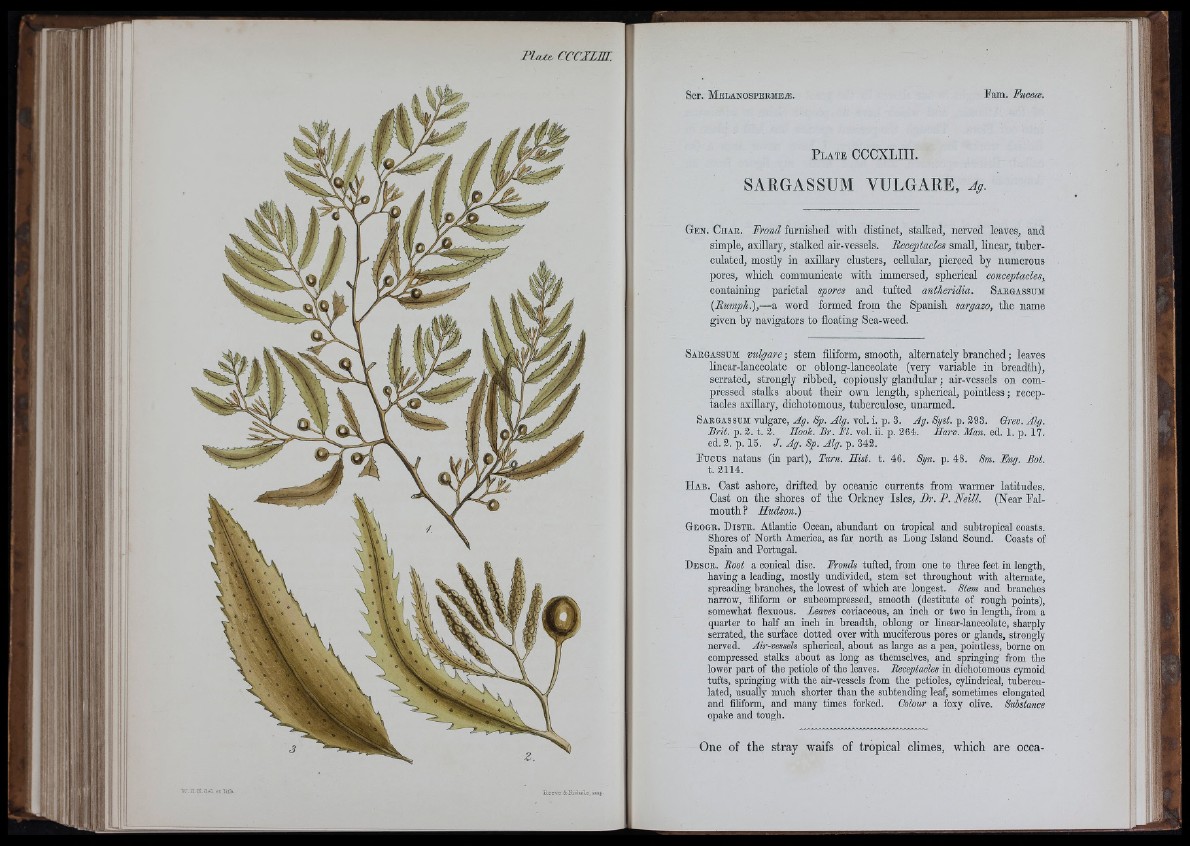
'
< r:
I' !
(
F iw te , c c c j i m .
P l a t e CCCXLIII.
SARGASSUM VULGARE, Ag.
G e n . C h a e . Frond furnislied with distinct, stalked, nerved leaves, and
simple, axillary, stalked air-vessels. Receptacles small, linear, tuberculated,
mostly in axillary clusters, ceUular, pierced by numerous
pores, which communicate with immersed, spherical conceptacles,
containing parietal spores and tufted antheridia. S a e g a s s um
[Rumph.),—a word formed from the Spanish sargazo, the name
given by navigators to floating Sea-weed.
S a e g a s s um vulgare; stem filiform, smooth, alternately branched; leaves
linear-lanceolate or oblong-lanceolate (very variable in breadth),
serrated, strongly ribbed, copiously glandular; air-vessels on compressed
stalks about their own length, spherical, pointless; receptacles
axillary, dichotomous, tuberculose, unarmed.
Saegassum vulgare, Ag. Sp. Alg. vol. i. p. 3. Ag. Syst. p. 393. Grev. Alg.
Brit. p. 2. t. 3. Hook. Br. M . vol. ii. p. 364. Harv. Man. ed. 1. p. 17.
ed. 3. p. 15. J. Ag. Sp. Alg. p. 342.
Fuous natans (in part). Turn. Hist. t. 46. Syn. p. 48. Sm. Eng. Bot.
t. 3114.
H a b . Cast ashore, drifted by oceanic currents from warmer latitudes.
Cast on the shores of the Orkney Isles, B r . P . Ne ill. (Near Falmouth
? Hudson)
Geoge. D is t e . Atlantic Ocean, abundant on tropical and subtropical coasts.
Shores of North America, as far north as Long Island Sound. Coasts of
Spain and Portugal.
De sc e . Boot a conical disc. Eronds tufted, from one to three feet in length,
having a leading, mostly undivided, stem set throughout with alternate,
spreading branches, the lowest of which are longest. Stem and branches
narrow, filiform or subcompressed, smooth (destitute of rough points),
somewhat flexuous. Leaves coriaceous, an inch or two in length, from a
quarter to half an inch in breadth, oblong or linear-lanceolate, sharply
serrated, the surface dotted over with muciferous pores or glands, strongly
nerved. Air-vessels spherical, about as large as a pea, pointless, borne on
compressed stalks about as long as themselves, and springing from the
lower part of the petiole of the leaves. Beceptacles in dichotomous cymoid
tufts, springing with the air-vessels from the petioles, cylindrical, tuberculated,
usuaUy mucb shorter than the subtending leaf, sometimes elongated
and filifom, and many times forked. Colour a foxy olive. Substance
opake and tough.
One of the stray waifs of tropical climes, which are occa